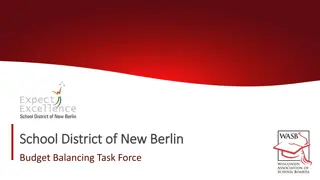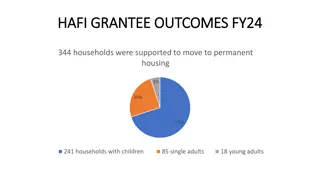Analysis of FY24 DoD Space Budget Requests for Space Force and Research & Development
The FY24 DoD Space Budget Requests show significant increases for the Space Force along with notable shortfalls and funding disconnects. The Space Force budget includes funding for core programs but also faces challenges in fully funding essential capabilities. The Research & Development budget sees a 15% increase above the FY23 enacted level despite reductions in certain areas, with strong support from various committees in key priorities.
Download Presentation

Please find below an Image/Link to download the presentation.
The content on the website is provided AS IS for your information and personal use only. It may not be sold, licensed, or shared on other websites without obtaining consent from the author.If you encounter any issues during the download, it is possible that the publisher has removed the file from their server.
You are allowed to download the files provided on this website for personal or commercial use, subject to the condition that they are used lawfully. All files are the property of their respective owners.
The content on the website is provided AS IS for your information and personal use only. It may not be sold, licensed, or shared on other websites without obtaining consent from the author.
E N D
Presentation Transcript
FY24 DoD Space Budget: Conference Outlook September 13, 2023 National Security Space Association nssaspace.org National Security Space Association nssaspace.org Data and analytics support provided by 1
DoD Space Budget Authorization Appropriation FY23 Request FY23 Enacted FY24 Request FY24 HASC FY24 SASC FY24 HAC FY24 SAC Space Force Air Force Army Navy OSD DoD Space Total$ 26.91 $ 24.60 $ 26.29 $ 30.20 $ 29.61 $ 30.23 $ 29.08 $ 29.05 $ 0.98 $ 0.78 $ 0.81 $ 0.78 $ 0.81 $ 0.77 $ 0.81 $ 0.80 $ 0.77 $ 0.75 $ 0.74 $ 0.75 $ 0.74 $ 0.77 $ 0.20 $ 0.20 $ 0.27 $ 0.28 $ 0.27 $ 0.28 $ 0.27 $ 0.33 $ 0.32 $ 0.42 $ 0.42 $ 0.42 $ 0.40 $ 0.41 $ 28.36 $ 32.44 $ 31.83 $ 32.48 $ 31.25 $ 31.31 In FY23 Congress added $1.5B+ over the request for DoD Space Programs Congress has not provided a similar increase in FY24, remaining largely consistent with budget request **NOTE: The DoD does not publicly release a full accounting of the program elements included in the space budget topline. Analysis reflects efforts to identify all program elements for space in the budget justification documents to the maximum extent possible.
Budget & Fiscal Policy Provisions HAC Report Language (emphasis added) Space Force Acquisition The fiscal year 2024 President s budget request for the Space Force is $30,197,634,000, an increase of $3,907,806,000 or 15 percent over last year s enacted level, continuing a trend of double-digit growth over the past several years. The request also adds a total of $16,080,860,000 through fiscal year 2027 compared to last year s projection over the same period. However, despite these significant increases, the budget request continues to include serious shortfalls and disconnects. The Space Force does not fully fund several core programs in the five-year budget projection None of these programs are new, and all are core capabilities the Space Force says it must have. Moreover, the Space Force should not count on continued double-digit topline budget increases to address future funding shortfalls or reduce acquisition risk.
Budget & Fiscal Policy Provisions SAC Report Language (emphasis added) Space Force Research and Development The fiscal year 2024 President s budget request for the Research, Development, Test and Evaluation, Space Force appropriations account includes $19,199,340,000 a 15 percent increase above the fiscal year 2023 enacted level. The Committee recommends $18,842,930,000, a reduction of $356,410,000. The Committee continues its strong support to the Space Force through resourcing its top unfunded priorities, fully funding the Chief of Space Operation s training initiatives and offering assistance in other key classified areas. Further, the Committee notes that all recommended program adjustments are non-prejudicial and based purely on the cost, schedule, and performance factors that were presented to the Committee. Finally, the Committee notes that its recommendation provides a 13 percent increase above fiscal year 2023 appropriations and a 63 percent increase above the fiscal year 2022 appropriation.
Budget & Fiscal Policy Provisions HAC Report Language (emphasis added) Space Force Mission Area Budget Exhibit Aware of various proposals over the years to consolidate and align budgets into capability portfolios. More directly connects national security strategy and goals to the Department s budget priorities, program plans, and ultimately to capabilities. May also bring greater transparency and accuracy to the true total cost and resources needed to accomplish mission goals. Worthwhile trial to understand how the Department might implement a new approach based on organizing around specific mission areas. Directs the SECAF, in coordination with the USD (Comptroller), to prepare a supplementary budget exhibit for Space Force programs that organizes and aligns the existing budget lines for programs, projects, and activities into mission area expenditure centers, such as missile warning, satellite communications, and position, navigation, and timing.
Budget & Fiscal Policy Provisions HAC Report Language (emphasis added) Space Force Mission Area Budget Exhibit (cont d) Should also include separate mission area expenditure centers for enterprise management, enterprise information technology, and facilities and logistics. Clear statement of the mission goals and plans, a detailed and compelling justification for the requested budget and military and civilian personnel needed for the mission, and an alignment of all the relevant individual program elements. Budget exhibits for the MIP and the NIP may serve as a potential model and starting point for consideration. Not a substitute for the budget documentation typically provided each year. Draft plan for the Space Force Mission Area Budget Exhibit to the House and Senate Appropriations Committees not later than September 1, 2023. Completed exhibit covering the entire Space Force budget request shall be submitted with the fiscal year 2025 President s budget request.
Space Sensing Next-Gen OPIR Sustains budget request proposal to cancel third geosynchronous spacecraft (GEO-3) in the Next Generation Overhead Persistent Infrared (OPIR) program, with reservations HAC: concern for the lack of analysis to support the proposal ; Requires report; fences funding for Resilient MW/MT MEO (10%) until report is delivered SASC: committee has not received comprehensive analysis ; Requires report SAC: -$406.0M for Next-Gen OPIR across four lines (-$261.9M Polar) HAC: Next-Gen OPIR ground FORGE not fully funded in FYDP Resilient MW/MT Support for Resilient MW/MT architecture investments by SSC (MEO) ($791.0M) and SDA (LEO) ($2.3B combined request) SAC: -$106.0M MEO SVs 1-6 savings SASC: Open competition within MEO MW architecture is the best path to deploying the most cost-effective and schedule-effective solutions ; requires briefing on acquisition strategy
Space Development Agency Funding Sustains the continued growth of SDA budget; minor oversight reductions from appropriators across the various lines Nearly unanimous full funding for SDA LEO component of Resilient MW/MT architecture ($1.5B request) Policy Provisions Middle-Tier Acquisition Authority SASC: Requires Director of SDA to use middle-tier acquisition authority for rapid fielding of satellites and associated systems for Tranches 1-3 of the Proliferated Warfighter Space Architecture (PWSA) of the SDA (NDAA Sec. 1505) White House SAP:opposes section; Tranche 1 transport and tracking layers already approved for the middle tier of acquisition; different acquisition pathway may be most appropriate for other tranches or elements HASC on Role in Missile Defense Architecture: not received details regarding how the PWSA contributions for missile warning will meet stated combatant commander resiliency requirements or be integrated SASC: Strongly encourage fill three (not two) Senior Executive Service (SES) billets
Assured Access to Space Funding NSSL: SAC net cut attributable to NSSL Procurement ( Cost Savings ) (10 NSSL launches) RSLP: Increased investment for state launched range services and capabilities from both HAC (+$7.0M) and SAC (+$25.0M) TAC-RS: Continued support, +$20.0M program increase from HASC and HAC Policy Provisions NSSL: use Phase 2 or Phase 3 contract vs. delivery on-orbit or commercial launch (HAC and SAC) NSSL Phase 3 Dual Lane: maximize competition HASC: Lane 1 new & emerging providers; Lane 2 NSSL launches SASC: Lane 1 low-risk not fewer than 20 launches; Lane 2 NSSL launches (30); Lane 2A accession launch program using five GPS III-F satellites (or similar) SAC: supports dual-lane; Lane 1 continued growth of commercial launch market, open competition DoD Legislative Proposal on Commercial Space Launch Support Services: Supported by HASC and SASC
Communications & PNT Funding SATCOM ESS: -$271.0M (SAC); 42% reduction across seven cuts including vendor termination PTS: -$126.5M (SAC); 35% reduction primarily attributable to concurrency COMSO: +$50.0M (SAC) for commercial remote sensing (SAR, EO/IR, infrared) OCX and GPS-IIIF: Cut by SASC, HAC and SAC; GPS-III: Cut by SASC and HAC Policy Provisions SATCOM - HASC: WGS-12 funds (-$434.0M) fenced and rescinded unless certified cannot be met by commercial SATCOM: rename COMSATCOM Integration to Commercial Services (COMSO) (SAC) SATCOM: FAB-T other poor performing (HAC) PNT - OCX: 73% cost growth and seven years late; HAC poorest performing PNT GPS User Equipment Increment 2 not fully funded in FYDP; Increment 1 other poor performing program (HAC)
SDA & Combat Power Funding Space Domain Awareness (SDA) lines fully funded; adds funding for commercial SDA capabilities (HAC and SAC) Orbital Warfare and Space Electronic Warfare generally funded at PB Policy Provisions SDA Deep Space Advanced Radar Concept not fully funded in FYDP (HAC) SDA Identify, evaluate and integrate commercial SDA capabilities (HASC) SDA Establish TAP (Tools, Applications and Procedures) lab (based on OPIR TAP lab success) to enhance the capability and utility of SDA data (SAC)
BMC3 Funding Minor cuts to AFSCN RDTE (HAC and SAC) ( Underexecution and Excess to Need ) Minor cuts to Space Mods due to Inadequate Justification predominance of HAC reduction Policy Provisions EGS other poor performing program (HAC) Space C2 other poor performing program (HAC) SASC on Space C2 in general Space Force Guardians serve in career specialties that require high performance under stressful conditions, such as command and control of space assets moving among large, congested constellations at high speeds over great distances.
Advanced R&D Funding Most volatile account across authorizers and appropriators; not unexpected due to broad scope of component programs Many small funding adds to innovative space technologies by all committees, for example: Advanced analog microelectronics - +$3.0M to +$8.6M (HASC, SASC, HAC) Small satellite chemical propulsion - +$3.0M (HAC) Lunar surface-based domain awareness - +$5.0M (SASC) Space situational awareness ground infrastructure - +$5.0M (SAC) Policy Provisions SASC Sec 802 Modernizing the Department of Defense Requirements Process; modernize JCIDS; improve alignment between modern warfare concepts, technologies, and system development and reduce the time to delivery SASC accelerate development of a robust and accurate simulation and training environment (+$15.0M)
Organizational Investments Funding Portfolio includes SWAC, SpRCO, SMC Civilian Pay; most uniform support across committees SWAC and analysis fully funded SpRCO adds from HASC (+$10.0M RF Signal Monitoring and Interference Detection) and SAC (+$7.0M digital beamforming ground-based C2) Policy Provisions NSIC SECAF may establish the National Space Intelligence Center as a field operating agency of the Space Force to analyze and produce scientific and technical intelligence on space-based and counterspace threats from foreign adversaries (HASC) Includes no provision restricting the stand-up of new field operating agencies and encourages the Secretary of the Air Force and the Chief of Space Operations to organize the Space Force such that it maximizes its warfighting capability (SAC) SASC GAO review of how USSF uses SWAC analysis, SWAC s approach and methodology, update and coordination
MILPERS Funding Single funding line for USSF personnel received minor undistributed adjustment from HAC and SAC Policy Provisions HASC report on how to enhance National Space Test and Training Complex (NSTTC) SASC Human Performance Optimization (+$5.0M to Space Development Agency portfolio); Guardians operate under stressful conditions SAC fully fund CSO training initiatives; funded in O&M portfolio HASC briefing on Air Force Operational Training Digital Infrastructure SASC development of a formal career path, training, and structure for requirements management professionals and chief architects (JCIDS modernization initiative)
O&M Funding Portfolio has grown to ten program lines Global C3I & Early Warning, Space Operations and Administration all reduced in part by each committee Facilities Sustainment, Restoration & Modernization received program increase from both SASC and SAC Policy Provisions SAC fully fund CSO training initiatives; funded in O&M portfolio
DoD-Wide Funding Unofficial portfolio contains 45+ programs, projects or activities outside of the USSF budget Includes AF funded USSPACECOM activities (RDTE, PROC and O&M); HAC cuts PROC funding (-$27.1M) for new Consolidated Space Operations Facility (CSOF) Includes DARPA Space Programs and Technology (small cuts from both HAC and SAC) Includes Army tactical comms user equipment (fully funded or increased) and assured PNT (fully funded or increased) Includes Navy SATCOM terminal and GPS user equipment Policy Provisions SASC Requires buying certain satellite components (traveling-wave tube and traveling wave tube amplifier) from national technology and industrial base SAC continue the development of radioisotope power systems that are capable of providing lightweight, always- on, resilient power to increase the capabilities of Department of Defense spacecraft SAC supports the development of space nuclear power and propulsion technologies, including those employing high- assay low enriched uranium; encourages DIU and CSO partnerships























